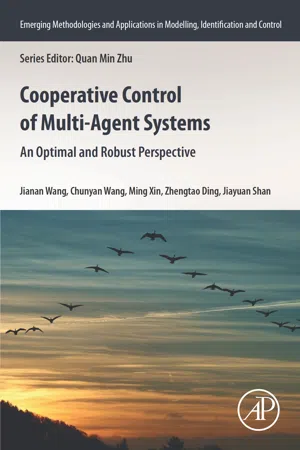
Cooperative Control of Multi-Agent Systems
An Optimal and Robust Perspective
- 258 pages
- English
- ePUB (mobile friendly)
- Available on iOS & Android
Cooperative Control of Multi-Agent Systems
An Optimal and Robust Perspective
About this book
Cooperative Control of Multi-Agent Systems: An Optimal and Robust Perspective reports and encourages technology transfer in the field of cooperative control of multi-agent systems. The book deals with UGVs, UAVs, UUVs and spacecraft, and more. It presents an extended exposition of the authors' recent work on all aspects of multi-agent technology. Modelling and cooperative control of multi-agent systems are topics of great interest, across both academia (research and education) and industry (for real applications and end-users). Graduate students and researchers from a wide spectrum of specialties in electrical, mechanical or aerospace engineering fields will use this book as a key resource.- Helps shape the reader's understanding of optimal and robust cooperative control design techniques for multi-agent systems- Presents new theoretical control challenges and investigates unresolved/open problems- Explores future research trends in multi-agent systems- Offers a certain amount of analytical mathematics, practical numerical procedures, and actual implementations of some proposed approaches
Frequently asked questions
- Essential is ideal for learners and professionals who enjoy exploring a wide range of subjects. Access the Essential Library with 800,000+ trusted titles and best-sellers across business, personal growth, and the humanities. Includes unlimited reading time and Standard Read Aloud voice.
- Complete: Perfect for advanced learners and researchers needing full, unrestricted access. Unlock 1.4M+ books across hundreds of subjects, including academic and specialized titles. The Complete Plan also includes advanced features like Premium Read Aloud and Research Assistant.
Please note we cannot support devices running on iOS 13 and Android 7 or earlier. Learn more about using the app.
Information
Introduction
Abstract
Keywords
1.1 Background




1.1.1 Motivations
1.1.2 Control architectures and strategies
1.1.3 Related applications
Table of contents
- Cover image
- Title page
- Table of Contents
- Copyright
- About the authors
- Preface
- Acknowledgments
- Part One: About cooperative control
- 1: Introduction
- 2: Preliminaries
- Part Two: Optimal cooperative control
- 3: Optimal consensus control of multiple integrator systems
- 4: Optimal cooperative tracking and flocking of multi-agent systems
- 5: Optimal formation control of multiple UAVs
- 6: Optimal coverage control of multi-robot systems
- Part Three: Robust cooperative control
- 7: Robust consensus control of multi-agent systems with input delay
- 8: Robust consensus control of multi-agent systems with disturbance rejection
- 9: Robust consensus control of nonlinear odd power integrator systems
- 10: Robust cooperative control of networked negative-imaginary systems
- Bibliography
- Index